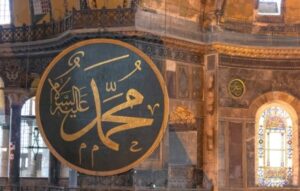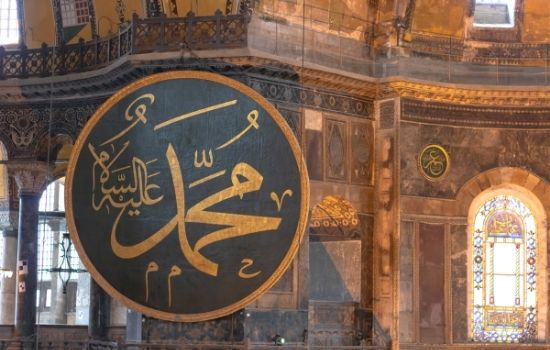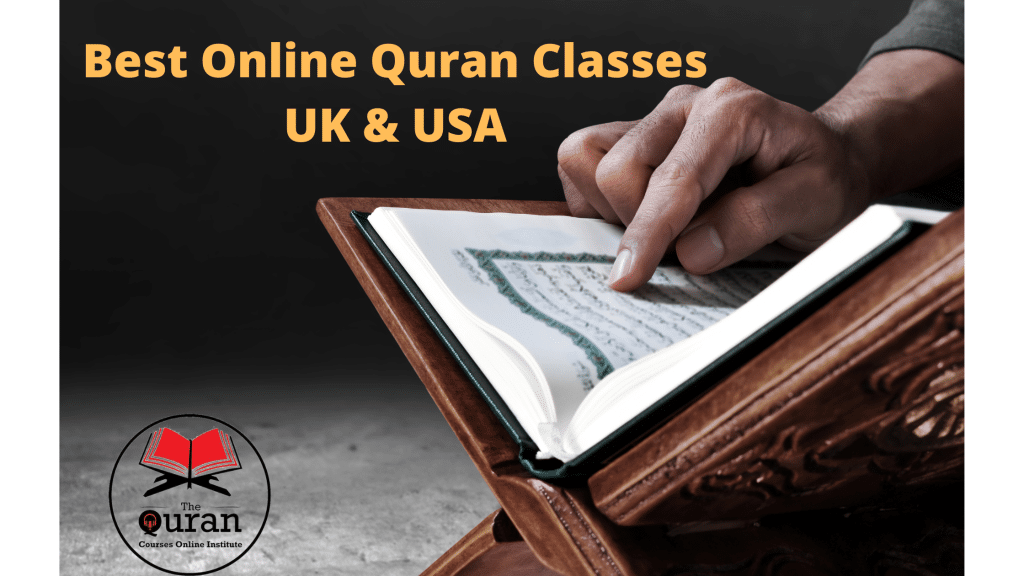Who founded Islam?
The Prophet Muhammad, founder of Islam.
There are many prophets in Islam who preceded the Prophet, Muhammad.
25 Prophets of Islam
Muhammad, one of the Prophets of Islam, was born in Mecca around 570 AD.
He was orphaned before reaching his sixth birthday; Muhammad was brought up by the uncle Abu Talib. Muhammad started working as a trader and was well-known for his honesty.

At around the age of 25, when he was about twenty-five, he got married to Khadija, an affluent widow who made Muhammad a prominent figure as a member of Meccan society. Muhammad, along with Khadija, was blessed with two children, one of whom died when they were infants. Around fifteen or twenty years after the marriage, he began having visions and hearing voices. He sought refuge in a cave situated on Mount Hira on the outskirts of Mecca. A few nights during Ramadan, which is the month that is a traditional one for prayer and meditation in the year when Muhammad was forty years old of age, the angel appeared to him in the shape of a man. The angel instructed him to.
Recite the name of the Lord who created man and made him from a clot
Recite in the name the Lord of your life,
Who taught through the pen,
The man was taught what he knew didn’t know.
Muhammad, who was scared that he was assaulted by the evil spirit He fled down the mountain with a scream of terror. The voice that sounded after him said, “O Muhammad, you are the messenger of God, and I am the angel Gabriel.” The revelation was quickly followed by other people about God being the only true God. The angel then instructed Muhammad to proclaim God’s message.
Muhammad gradually started to draw some followers, many of whom were young and had low social statuses, such as his cousin Ali who was the son of his uncle and his protector Abu Talib. After Muhammad began to challenge the ancient polytheism of his home town The powerful and wealthy merchants of Mecca were aware that the revolution happening right in front of their eyes could be disastrous for their business, which was shielded through Mecca’s Meccan worship of goddesses and gods.
The elites of the ruling class gathered with Muhammad as well as his adherents and began to harass them. A handful of Meccans accepted Muhammad’s teachings, while others in his family were drawn to their kinsman from the perspective of loyalty to the family, even though they didn’t yet believe in his cause.
Muhammad’s place in Mecca was bleak when his spouse Khadija along with his grandfather Abu Talib died in quick succession. In 622, the Mecca rulers who were local to Mecca ordered Muhammad along with small group members to flee Mecca. Muhammad was invited to move into Yathrib, the desert oasis. Yathrib was situated about 11 days (280 miles) north of the city by camel because the oasis was close to being destroyed by the war between clans, and many were Jewish.
Mohammed’s Hegira from Mecca signifies the start of the new political system. It was the first time that in Arabia, the members of a community were not bound by the traditional bonds of tribe and clan but rather by their faith in the one and only God. The later believers, when looking back at this time and recognizing its significance, praised it by naming it the beginning of their new time. In recognition of this historical moment, this oasis in Yathrib became known as Medina, “the city [of the Prophet].”
The Prophet Muhammad and the Origins of Islam
The growth of Islam is inextricably linked to the Prophet Muhammad was considered to be the Prophet of Islam by Muslims as the final in a line of prophets, which include Moses as well as Jesus.
Since Muhammad was the one chosen to receive and transmitter of the word of God through divinity revelations, Muslims in all aspects of their lives trying to follow the example of his. Following the holy Qur’an and the words that the Prophet spoke ( hadith) and his descriptions of his manner of living ( sunna) are among the most significant Muslim texts.
Muhammad, who was surrounded by followers
Muhammad, who was surrounded by followers, was amidst his followers in Medina for 10 years. He gradually won over new converts. Muhammad repeatedly tried to entice Jews in his favor. For, for instance, he commanded that followers worship as Jews to the point of Jerusalem.
In the end, his efforts were unsuccessful, and for the rest of his life, Muslims worshiped the Kaaba in Mecca. Muhammad’s hometown was long an important center for paganism, was then transformed into the heart of the religion that was true as well as the central point of believers’ daily prayers, and later the purpose to be the focus of their annual journey.
Riding and war were the principal economic pursuits of the new community of Medina, and the affluent caravans led in the name of The Quraysh from Mecca were extremely attractive targets.
Sixteen years later, Muhammad was able to negotiate a peace treaty between the Meccans and later in the next year, and he returned to the holy city places. His followers were murdered by one of them. Led him to take on the city, and it quickly was able to surrender. Muhammad showed great kindness towards the Meccans and demanded that the pagan worshipers around Kaaba be destroyed.
Kaaba was destroyed. Muhammad’s popularity grew after his surrender to the Meccans. Embassy representatives from across Arabia were at Medina to bow to his. Muhammad’s life-changing achievements and life were ended by the sudden passing of his body on the 8th of June 632 at the age of sixty years old, just a decade after his departure from Mecca with a small group of followers.
Early Life
Muhammad was born to one of the strongest tribes of Mecca, known as the Quraish, in the year 570 A.D. The strength of the Quraish resulted from their role as merchants, who were successful. Numerous trade routes interconnected at Mecca allowed the Quraish to regulate trade across the western coasts of Arabia and north to Syria and south to Yemen.
Mecca was the site of two cults of polytheism that were revered by the masses, which believed to protect the lucrative trade. After a long time as a trader, Muhammad was commissioned by Khadija an affluent widow, to ensure the secure transport of her caravans into Syria. They eventually got married.
Divine Revelations
At the age of 40, Muhammad began having visions and hearing voices. In search of clarity, he would often contemplate on Mount Hira, near Mecca. In one of these instances, it was when it was said that the Archangel Gabriel ( Jibra’il in Arabic) appeared to him and directed him to repeat “in the name of [your] lord.” It was one of the first revelations that would later become the foundation of the Qur’an, the holy book of Islam. The early revelations suggested the existence of one God and rebutted the polytheistic beliefs that were prevalent in earlier times in the Arabian Peninsula.
Initially shocked by the significance of the information being presented to Muhammad, Muhammad found unflinching support from his wife and gradually began to gain followers. His monotheistic stance angered most members of Meccan merchants.
They were concerned that the trade that they believed to be secured by the gods of pagan religion was going to suffer. From then on, Muhammad was ostracized in Mecca. At times the power and position of his wife, as well as his Uncle, Abu Talib, the head of the clan, secured Muhammad from being a target of persecution. When they passed away, however, Muhammad’s position in Mecca turned dire.
The Hijra
Emigration was the only option to ensure Muhammad, along with his followers to survive. In 622, they fled to Medina, which was another oasis town, and were granted freedom to follow their faith. The journey between Mecca in 622 to Medina is called”the hijra–the flight. It is also the beginning of year one on the Islamic calendar, also known as the Hijri calendar.
Spreading the Message of Islam
Within Medina, Muhammad continued to receive divine revelations, and he built an ever-growing community around the new religion. The war with the Quraish was not over, and after a number of years of violent fighting, Mecca surrendered. Muhammad, along with his followers, returned and seized Mecca, demolishing every idol of pagan worship and spreading their faith that there was one God.
The Night Journey and Ascension of the Prophet
The ascension stories (Mi’raj ) from Muhammad have fascinated artists and writers for decades. In the night, as the Prophet was asleep in his bed, the Archangel Gabriel appeared and took him on a trip. He was atop the celestial horses Buraq, Muhammad journeyed from the Ka’ba located in Mecca up to Mecca’s “Farthest Mosque,” which Muslims believe is believed to be the Al-Aqsa Mosque in Jerusalem.
He prayed there alongside other prophets, such as Moses, Abraham, and Jesus, and then flew to the heavens, which is where he was guided through the angelic guidance of Gabriel to Paradise and Hell before finally coming confronted with God. Then he returned to earth to spread messages of Islam. According to the Islamic faith, Muhammad was the only person who could see Heaven as well as Hell while alive.
The model of the perfect believer
Muslims still are still devoted to Muhammad as the model of the perfect believer. They regard his actions and words as a model for ideal behavior. Contrary to Jesus, who Christians believe to be God’s only son, Muhammad is a mere mortal, however, with exceptional qualities.
Nowadays, many Muslims believe it’s not right to portray Muhammad, but this wasn’t always the situation. At different times and locations, religious Muslims were able to portray Muhammad, but they did not worship the images of Muhammad.
After the Prophet’s Death: Emergence of Shi’i and Sunni Sects of Islam
After Muhammad was killed in 632, he did no successor named. A particular group, the Shi’a, believe that only those with direct ancestry to Muhammad could morally lead the Muslim community. They believed that ‘Ali was Muhammad’s closest blood male close relative was their future chief ( caliph). The other, called the Sunnis were of the opinion it was the Prophet’s destiny must be chosen by consensus. they elected three of his closest companions, usually known as”the rightly guided Caliphs (Abu Bakr and ‘Umar and ‘Uthman) as the leaders for the Muslim community. ‘Ali succeeded as the fourth caliph.
The Islamic community remains divided between Sunni as well as Shi’i groups. Sunnis are devoted to the four caliphs, whereas Shi’is consider ‘Ali to be an early spiritual leader. The division between the two groups has led to disagreements in the worship of God as also in religious and political opinions. Sunnis are the largest and comprise the majority areas of the Muslim world, and Shi’i communities are mostly on the borders of Iran and Iraq, and Iraq, with a significant number of Shi’i living across Bahrain, Lebanon, Kuwait, Turkey, Pakistan, and Afghanistan.
Depictions of the Prophet Muhammad
The subject matter of this unit includes numerous pictures that depict the Prophet, Muhammad. The depictions, though unusual, are not uncommon because there were (and continue to be) diverse views on depicting the Prophet, as well as people in general, throughout the Islamic world. These views varied greatly between regions and across time; the societies that created these works are among the ones that allowed the portrayal of Prophet Muhammad.
The images were commissioned through Muslims for Muslims. These images are found in the biographies of Prophet Muhammad as well as his family, in the world or local historical accounts, stories of the celestial journey of Muhammad ( mi’raj), and in the texts of literature. Each time they serve a specific function. They are used to illustrate narratives in biographies and histories, and in literary works, they function as visual representations of written praises for the Prophet. A picture depicting the Prophet Muhammad at the start of a book confers the book with the greatest kind of blessing and sanctity. Therefore, depicting his image was standard practice, especially in the eastern regions in the Islamic world



